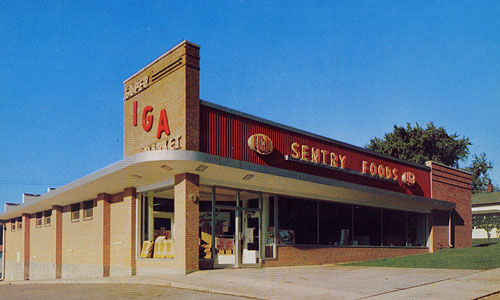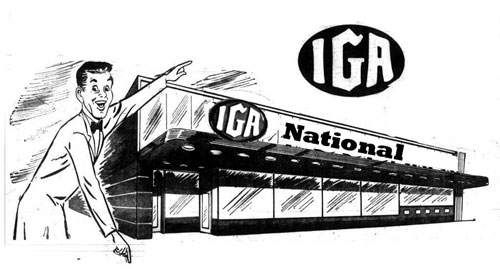Hometown Proud
The Independent Grocers Alliance (IGA), a loosely franchised grocery chain, is basically designed to allow locals to own their own stores. It's genius.
Black Friday has barely just started and you’re probably already sick of it. In an attempt at counter-programming, here’s a classic Tedium piece about a grocery store chain that represents little of that rampant consumerism.

What makes IGA worth discussing, anyway?
It's easy to find stacks of business books and magazine articles written about Walmart founder Sam Walton or McDonald's mastermind Ray Kroc. (Heck, in Kroc's case, he even inspired a movie starring Michael Keaton that's coming out later this year.)
But in the case of the Independent Grocers Alliance, you won't find a single mention of J. Frank Grimes on many business sites, despite the fact that Grimes did something arguably more impressive than either of those business figures: He made it possible for small-town grocers to remain competitive in their given market without losing their homespun identity.
While IGA, founded 1926, was a somewhat early example of the franchise model, it differed in an important way: Instead of trying to set up the ramifications for how these local businesses should be run—say, specific building designs, like you might run into at a McDonald's—it instead offered different kinds of help to those retailers. That help, traditionally, has come in the form of marketing and access to a consistent supply chain. After a few years, the company even began making its own canned foods.
IGA helped its members, but when it came down to it, the owner of the store was still the guy in the stock room, writing reports and cutting the checks.
And Grimes (who, it should be said, was very much the opposite of his Simpsons counterpart) helped to make the case to allow these family businesses to stay alive. In 1929, in the wake of the Great Depression, he spoke about how family businesses were well-suited to hold their own during an economic crisis.
“Great businesses are drawing in and becoming fearful, and adding to the unrest and unemployment,” Grimes said, according to Supermarket News. “Right at this time, the opportunity is golden for men to go out and do business courageously, with determination, and prove that America is not dead yet. That there are men thinking and unafraid.”
Grimes' evocative talk certainly helped, and small stores quickly flocked to the concept. The collective gave consumers something of a brand name that they could recognize no matter where they traveled, and made it easier for grocery stores to market themselves in newspapers and on television.
This thought process worked well for IGA, which grew quickly, convincing thousands of independent supermarkets to join the alliance. In a 1986 article on the company in the Chicago Tribune, then-IGA president William Olsen spoke in terms of IGA's philosophy when asked how the firm would tackle superstores.
"We have to deal from our strengths," Olsen said. "We have the owner in the store. We are flexible enough to serve the consumer. Good service, clean stores, and a competitive value are our strengths."
It's a different line in the sand to take from "always low prices," but it's a welcome road for a retailer to take.
In 1966, on the company's 40th anniversary, then-Senate Majority Leader Mike Mansfield (D-MT) gave the company a round of praise on the Senate floor.
"This organization has helped independent grocers in 46 states to increase their sales and modernize their stores," Mansfield said. "IGA has become the world's largest voluntary foodstore chain. It has given its members the same tools as those of their larger corporate competitors, and there are several markets where IGA independent grocers are the sales volume leaders."
It's no shoutout in the Harvard Business Review, but certainly a nice consolation prize.
30+
The number of countries where IGA currently has a presence. After longtime associate Thomas Haggai became CEO in the late '80s, the company made an aggressive push into a number of other countries where the independent store concept translates. The approach did particularly well in Australia, where IGA is one of the country's largest grocery brands. (Haggai, by the way, currently serves as the company's chairman emeritus.)

Five bizarre facts about IGA that you probably didn't expect me to write
- Paul Anka owes his career to IGA. The reliably square crooner and songwriter, looking to make his way to New York City, spent three months collecting Campbell's soup labels in an effort to win a contest at his local IGA store. He won the contest, and the trip, and somehow leveraged that trip into a 60-year career.
- IGA attempted to sell crow in a can. Either completely unaware of crow's status as a food one metaphorically eats when wrong, or banking on the fact that people frequently eat actual crow for that reason, IGA attempted to sell local stores on the idea of crow in a can at a 1937 conference, according to a New York Times brief from the era. Clearly, it worked, because we eat crow all the time these days.
- There's an IGA location in Guam. Playing against the perception of IGA as an icon of small-town Americana, an IGA store opened on the tiny Pacific island, population 165,718, back in 2009. “Our residents are not only pleased at the fact that island fresh IGA is making every effort to offer retail goods at competitive prices, but they have offered to our residents competitive job opportunities in a struggling economy,” Chalan Pago-Ordot Mayor Jessy Gogue said in a newsletter article published by the North West Company. (By the way, the North West Company has an interesting business model; the Canadian firm, which claims roots that date back to 1668, specifically focuses on under-represented retail markets worldwide.)
- A Prescott, Wisconsin IGA store is home to the world's longest beer brat. Ptacek's initially did this gimmick for its 100th anniversary, but kept it around after the gimmick proved garnered the store media attention.
- IGA runs an institute for its members to train on new initiatives in the grocery sector. The name of the institute is the best part: It's called the IGA Coca Cola Institute, which makes one wonder what a university would look like if it was branded by a sugar-water manufacturer.

Why newspapers should look really closely at IGA's business model
You know a business model is in trouble when Warren Buffet's Berkshire Hathaway doesn't know what to do with one.
That situation came to light in 2012, when The News and Messenger, a Manassas, Virginia mainstay, shut down after 143 consecutive years in publication.
“It is too bad,” noted Terry Kroeger, the chairman of Berkshire's World Media subsidiary, told The Washington Post. “We didn’t see a way to take the negative financial momentum and turn it positive.”
Buffett certainly hasn't given up on newspapers—he owns the Richmond Times-Dispatch, within relative shouting distance of the paper he closed. But it's easy to see how making the model work can be a challenge in some markets.
Not everyone's having such bad luck with community papers, though: They're doing OK when you tighten the microscope and focus on tiny papers. An Editor and Publisher piece on the topic noted that some very small newspapers are doing well—the kind that publish in the types of towns where IGA makes its bread and butter, in fact.
Doug Caldwell, the publisher of the Petoskey-News Review in Petoskey, Michigan, notes that the paper holds its own in its community despite competition for readers' time.
"Our readership recognizes the value of the local newspaper. We are the cheerleader, guardian and watchdog all rolled up in one," Caldwell said. "We monitor the pulse of the community and focus on local news stories of interest—not what [newspaper editors] want but what our readers want in their community newspapers."
This sort of earthy quality gets lost on most chain-newspaper websites, replaced by a robotic desire to send us content in the most efficient way possible, with Taboola ads just about everywhere.
I wonder if part of the reason that we rolled our eyes when we heard about Tribune’s name change to Tronc or cower when we read a clickbait headline is because we know that there's another layer of crap in the way letting us know about our community.
And then there's the homogenization factor. A lot of newspaper companies, have in recent years taken to pushing redesigns on their sites that are essentially reskinned versions of what larger newspapers in the portfolio are using. Specific functions, like copy-editing and design, have been shopped out of the local market. It's no longer just wire copy any more—entire pages are being completed hundreds of miles away from where the newspaper's editors are.
And it's all out of a desire to maximize profits. But what if, like IGA, newspaper companies didn't solely exist to maximize that profit, but to respect the value of the local community? What if Gannett decided to donate one of its papers to a local philanthropist who has a larger stake in the community than Gannett does? Gannett could help run some of the most profitable and technical functions, but the company would otherwise be hands-off on how to control the paper. It could offer some guidelines, but the destiny's in the community's hands.
That approach is what IGA does, largely. The store stays in local hands, with local interests, and local history. IGA helps them keep up with trends, without losing track of the store's identity in the process.
And, largely, it works. It really should be studied in business books.
In a world where their Facebook is Walmart and their Twitter is Whole Foods, the many stores of IGA have found their niche and serve their communities effectively, even to this day.
But let's be clear—there are limits to even what IGA can do. In recent years, food deserts, or places where nutrition is hard to come by without leaving the area, have become a key point of contention in many urban areas. These food deserts, however, also affect rural areas, an issue highlighted as far back as 2007 by the Rural Sociological Society.
A piece on the topic published by Al Jazeera America highlighted the plight of one Nebraska resident who has to travel long distances just to fill his fridge.
“We have to drive 45 minutes to get it,” Roger Chilen noted, “You spend $20 on gas to go to the grocery store. And when you’re living on Social Security, you don’t go unless you have to.”
Chilen and his wife end up doing a lot of gardening and pickling of foods to help fill the gaps, but the situation is one where the demand far outpaces the supply—where people who want food have just a handful of places to go to get it.
Part of the problem is that the demographics of the area are unattractive to chains, who feel they won't make enough money to make the endeavor worthwhile, so they disregard the market. Their best shot might be to win over an independent grocer willing to take a chance on them.
That's where IGA, slogan "Hometown Proud," could come in handy.
:format(jpeg)/2017/06/tedium070716.gif)
/2017/06/tedium070716.gif)

/uploads/ernie_crop.jpg)